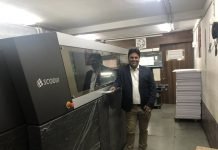The opening day of the two-day international news media forum, The Media Rumble, which took place at India Habitat Centre, New Delhi, on 2 and 3 August 2019, featured some of the most experienced news professionals from across India and the globe, including Dominique Sigaud, Anant Goenka, Nidhi Razdan, James Wright, Christina Lee, and others. Conceived by the independent news portal and media critique website Newslaundry, and produced by pioneering entertainment and arts company Teamwork Arts, the first-of-its-kind forum returned with its third edition to explore news, what it is, what it can be, and the economics and technology behind current trends in the news media.

The inaugural address at the third Media Rumble marked the start of the forum where Madhu Trehan, Newslaundry’s founder and editor-in-chief, said that there has never been a better time to talk about issues related to journalism, considering the fact that the credibility of the institution is in question. “We journalists are meant to speak truth to power. These are clichés which are often repeated but they need to be repeated today. Journalism is losing trust of the people,” she said. Sanjoy K Roy, managing director of Teamwork Arts, said that a strong and accountable media plays one of the most important roles in any democracy and we too as citizens have a certain responsibility to uphold.

Madhu Trehan ,Editor -in Chief and Co-Founder News Laundry
The Media Rumble explored a critical theme of equitable representation ‒ that of women in news, encompassing print, broadcast and digital, and of caste representation across newsrooms, op-ed pages, TV panels and radio stations. The forum launched two specially commissioned reports, one on ‘Gender inequality in Indian media’ in collaboration with UN Women and the second one on ‘Representation of marginalized caste groups in Indian newsrooms,’ in collaboration with Oxfam India. The comprehensive researches, which took place over a six-month period, went through a study of 24,133 newspaper articles, 3162 TV debates, 21,000 online articles and 981 magazine articles, bringing to the forefront some alarming statistics.

The panel discussions following the launch of these reports discussed the pertinent issue of participation of women and the representation of caste groups, which is not just limited to the media. The panel comprised film director Aishwarya Dhanush; Anant Goenka, executive director of the Indian Express Group; Nishtha Satyam, deputy country representative for India at UN Women; and Priya Ramani, weekly columnist for Mint and contributing editor at Vogue. Conversations ranged from exploring reasons why women do not enter the field of media to questioning if representation is the magic bullet to change or do we need more. The discussion started off on a unanimous note that representation has gotten better in relation to the 80s and early 90s and thus there is hope for the future too.
Moderated by Cynthia Stephen, the panel on caste representation comprised Akash Poyam, founder of Adivasi Resurgence; Amitabh Behar, chief executive officer of Oxfam India; Christina Thomas Dhanaraj, advisor at #dalitwomenfight and #Smashboard; and Sudipto Mondal, investigative journalist. The results of the report exposed that the numbers were dismal and representation of Dalits and Adivasis in the media was far from fair. Cynthia started off the discussion saying that journalism has played an important role in India’s narrative since the time of the freedom struggle and suppression of journalism became a key issue during the Emergency, which is why it is necessary now to delve into representation of the marginalized in the media. Mondal talked about the change brought about with the third Ambedkarite wave that had been triggered by the death of Rohit Vemula. Interest had been evoked amongst journalists’ thus increasing reportage on caste. Both Poyam and Mondal agreed that caste was not an issue but a perspective that allowed one to look at any piece of news through a different lens. The panel concluded with the thought that most stories on Adivasis are ironically covered by the dominant castes, which itself puts into question the essence of equitable representation.

Nikhil Pahwa, founder and editor of MediaNama; president of Internet and Mobile Association of India, Subho Ray; and Amba Tak, global policy advisor at Mozilla, the makers of the open source browser Firefox, explored the theme of ‘Digital Freedoms,’ and sought to unpack the legal, practical and technological challenges in regulating speech online without inhibiting liberty. The panel further spoke about how the Internet was originally seen as a safe platform to share opinions, explore diverse interests and interact with people freely, but has transformed into a space where the loudest and richest voices win. Kak stated that the ‘main problem’ with internet platforms, were ‘the business models’ they were built upon, which allowed those with more money or the most sensationalist opinions to gain the most reach. ‘The Internet can now be weaponized,’ added moderator Samir Saran, who explained how large corporations deliberately influence users’ political and commercial choices, a powerful tool for those with a sinister agenda.
‘Hindi News Channalo ka Vartaman’ had veteran multimedia journalist Milind Khandekar; Indian voice-over artist, former news anchor and entrepreneur, Shammi Narang; award-winning journalist, Smita Sharma; and national award-winning filmmaker and TV journalist, Vinod Kapri. Milind spoke about news channels being TRP driven, which clearly affects the kind of news that is being shown. On the topic of news channels being unethical, Kapri said that currently, truth being aired on news channels is often considered as running an agenda against a particular person or group. Adding to that, Sharma said that with changing times, we have seen the newsrooms change from only news-driven to infotainment-led. Today, news lacks quality and those who show courage to change it for good, are asked to pack up and leave, was the sentiment that echoed.

Must the relationship between journalists and the establishment be one of combat? How effective is it in change for the better? In a stirring discussion, moderated by Shereen Bhan, managing editor of CNBC-TV 18, the panelists discussed the relationship between ‘Media and the Establishment.’ Sarajevo-based Organized Crime and Corruption Reporting Project Correspondent, James Wright lamented the fact that we are in the ‘golden age of journalism but there’s no gold left’. Anant Nath, editor of The Caravan and the executive publisher of Delhi Press, added that the rise of direct communication between the powerful and the masses via the Internet has made traditional media redundant. Nidhi Razdan, award-winning journalist and NDTV’s executive editor, raised a more worrying trend – ‘When people agree that asking the government questions makes you “anti-national” then we have a problem.’ But despite the overwhelming subjugation of voices critical of the establishment, Wright concluded the session on a guardedly optimistic note saying that people would once again choose the ‘most accurate news out there’.
‘Journalism as a high-risk profession’ focused on issues involved in high risk reportage, specifically the challenges faced by women journalists. Sandhya Ravishankar, a freelancer whose investigations into the sand-mining mafia in Tamil Nadu led to legislation that banned sand-mining by private players, said it was ‘lonely and creepy’ knowing that there were people gunning for you. Pushpa Rokade, who works with Dainik Prakahar Samachar and reports from the interiors of Bijapur, said that she wanted to narrate stories of Adivasis because these stories did not get told. Being an Adivasi herself, she “did not feel scared” and was determined to continue reporting. The panelists at Media Rumble spoke about molestation being a regular feature of crowd reporting, women reporters being more vulnerable, and how media fraternity needs to stand strong alongside their members, well before it leads to a fatality. Deepanjana Pal, the moderator, aptly summarized the sentiment in the room, “We are expected to give voice to certain things and some of us are able to do it. It would be great if we could foster an environment where it is not as hard for us to be able to do it.”
The Media Rumble also featured interactive masterclasses and presentations on digital security training, exploring pathways to data-driven journalism using open budgets india, how to rearchitect the news ecosystem to support trust and sustainability, among others. The film screening of ‘Rosewater’ gave a glimpse of what happened when Iranian Canadian journalist and filmmaker Maziar Bahari was detained by Iranian forces and labeled a spy. The screening was followed by a Skype conversation between Maziar Bahari and Deepanjana Pal.
On Friday, the sessions on gender in cinema, dissecting the #MeToo tsunami, automation of news, collaborative journalism, the politics of cinema, layers of identity in writing and journalism, along with film screenings and workshops, were on the anvil.

















